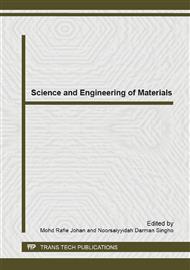p.279
p.283
p.288
p.293
p.299
p.304
p.308
p.312
p.317
Alumina Reinforced Epoxidized Natural Rubber in Latex Phase Mixing: Effect of Alumina Content
Abstract:
This work is preliminary studied of alumina-reinforced epoxidized natural rubber prepared via latex-mixing method without coupling agent. The effect of alumina content on distribution of filler and mechanical properties was investigated. Epoxidized natural rubber latex (ENR) was synthesized by in situ epoxidation of natural rubber using formic acid and hydrogen peroxide. The vulcanizing chemicals and alumina were then added in to ENR latex. The alumina content was varied from 10 to 75 phr. Prevulcanization at 70oC for 24 h and post-vulcanization at 110oC for 15 minutes was performed. The mixing time for a hour at mixing speed 600 rpm was chosen due to it shows the regular dispersion of filler in the matrix. The alumina content which can be added in epoxidized natural rubber decreased as epoxidation increased. The amount of alumina added was limited by the rigidity of high epoxidation content rubber. Modulus was increased with the increased of alumina content, whereas at alumina content 10 phr give the highest tensile strength corresponding to well dispersion of filler in matrix. Alumina addition in epoxidized natural also increases the hardness of rubber, which results to decreasing of rebound resilience property. This may caused by molecular stiffness of epoxide ring in ENR and excellent hardness of alumina particle. Furthermore, alumina addition also enhances a thermal stability of composite.
Info:
Periodical:
Pages:
299-303
Citation:
Online since:
June 2014
Authors:
Keywords:
Price:
Сopyright:
© 2014 Trans Tech Publications Ltd. All Rights Reserved
Share:
Citation:


